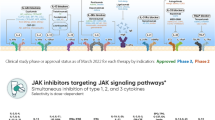Abstract
In a model for mucosal mast cells (RBL-2H3 cells) a set H1-antagonist derived anti-allergic drugs containing a diphenylmethyl piperazinyl moiety was examined for their ability to inhibit release of the mediatorβ-hexosaminidase. Cells were activated with antigen or the calcium ionophore A23187, whether or not in combination with the phorbol ester 12-O-tetradecanoylphorbol-13-acetate (TPA). Oxatomide, hydroxyzine and cetirizine inhibit the antigen inducedβ-hexosaminidase release. The release triggered by A23187, whether or not in combination with TPA is hardly influenced by the compounds. A biphasic dependence of the inhibition of exocytosis in RBL cells on lipophilicity is observed with the optimum at log P is 5–6. The extremely lipophilic compounds meclozine and buclizine are not active in this model. pH dependence of the effect of the drugs shows that especially the uncharged species are active in inhibiting exocytosis. The investigated compounds show an effect on phase transitions in L-α-phosphatidylcholine dipalmitoyl liposomes as assayed with differential scanning calorimetry (DSC). For the less extremely lipophilic compounds the induced changes in the phospholipid membranes increased with lipophilicity. The relation between structural features of the drug and the interaction with phospholipids is discussed in view of the DSC results. We conclude that location of the active drugs at the membrane or the membrane/protein interface is important for the inhibiting activity on exocytosis. This could affect several membrane related processes, which are abundant in the early phases of the IgE-mediated signal transduction process.
Similar content being viewed by others
Abbreviations
- RBL:
-
2H3 cells, a subline of rat basophilic leukemia cells
- TPA:
-
12-O-tetradecanoylphorbol-13-acetate
- A23187:
-
calcium ionophore
- LDH:
-
lactate dehydrogenase
- DSC:
-
differential scanning calorimetry
- DPPC:
-
L-α-phosphatidylcholine dipalmitoyl
References
Holgate ST. Mast cell activation in asthma. Intrinsic Asthma 1989;28:57–66.
Metcalfe DD, Kaliner M, Donlon MA. The mast cell. CRC Critical Rev Immunol 1981;3:23–74.
Kay AB. Asthma and inflammation. J Allergy Clin Immunol 1991;87:893–910.
Barnes PJ. Biochemistry of asthma. TIBS 1991;16:365–9.
Townley RG. Anti-allergic properties of the second-generation H1 antihistamines during the early and late reactions to antigen. J Allergy Clin Immunol 1992;90:720–5.
Estelle F, Simons R. The antiallergic effects of antihistamines (H1-receptor antagonists). J Allergy Clin Immunol 1992;90:705–15.
Rimmer SJ, Church MK. The pharmacology and mechanisms of action of histamine H1-antagonists. Clin Exp Allergy 1990;20:Suppl. 2:3–17.
Tasaka K, Mio M, Okamoto M. Intracellular calcium release induced by histamine releasers and its inhibition by some antiallergic drugs. Ann Allergy 1986;56:464–9.
Lau HYA, Pearce FL. Effects of antihistamines on isolated human lung mast cells, basophil leucocytes and erythrocytes. Agents Actions 1989;27:83–5.
Tasaka K, Akagi M, Izushi K, Mio M. Antiallergic effects of astemizole on immediate type hypersensitivity reactions. Meth Find Exp Clin Pharmacol 1990;12:531–9.
Ozawa K, Szallasi Z, Kazanietz MG, Blumberg PM, Mischak H, Mushinski JF, Beaven MA. Ca2+-dependent and Ca2+-independent isozymes of protein kinase C mediate exocytosis in antigen-stimulated rat basophilic RBL-2H3 cells. J Biol Chem 1993;268:1749–56.
Sainz MC, Chantres JR. Elorza B, Elorza MA. DSC study of the action of phenylbutazone on DMPC and DPPC bilayers. Int J Pharm 1993;89:183–90.
Hwang S, Shen TY. Membrane effects of antiinflammatory agents. 2. Interaction of nonsteroidal antiinflammatory drugs with liposome and purple membranes. J Med Chem 1981;24:1202–11.
Vassault A. UV-method with pyruvate and NADH. In: Methods of enzymatic analysis (Eds. Bergmeyer HU), Vol. III, pp. 118–126. Verlag Chemie, Weinheim, 1983.
Bangham AD, Standish MM, Watkins JC. Diffusion of univalent ions across the lamellae of swollen phospholipids. J Molec Biol 1965;13:238–53.
McElhaney RN. Differential scanning calorimetric studies of lipid-protein interactions in model membrane systems. Biochim. Biophys Acta 1986;864:361–421.
Hansch C. Comprehensive Medicinal Chemistry, Vol. 6, Pergamon Press, Oxford, 1990.
Thomas PG, Verkleij AJ. The dissimilar interactions of the calcium antagonist flunarizine with different phospholipid classes and molecular species: a differential scanning calorimetry study. Biochim Biophys Acta 1990;1030:211–22.
Lau HYA, Pearce FL. Effects of antihistamines on isolated rat peritoneal mast cells and on model membrane systems. Agents Actions 1990;29:151–61.
Lo TN, Saul W, Beaven MA. The actions of calciumionophores on rat basophilic (2H3) cells are dependent on cellular ATP and hydrolysis of inositol phospholipids: a comparison with antigen stimulation. J Biol Chem 1987;262:4141–5.
Benhamou M, Gutkind JS, Robbins KC, Siraganian RP. Tyrosine phosphorylation coupled to IgE receptor-mediated signal transduction and histamine release. Proc Natl Acad Sci USA 1990;87:5327–30.
Conklyn MJ, Kadin SB, Showell HJ. Inhibition of IgE-mediated N-acetylglucosaminidase and serotonin release from rat basophilic leukemia cells (RBL-2H3) by tenidap: a novel anti-inflammatory agent. Int Arch Allergy Appl Immunol 1990;9: 369–73.
Pfeiffer JR, Seagrave JC, Davis BH, Deanin GG, Oliver JM. Membrane and cytoskeletal changes associated with IgEmediated serotonin release from rat basophilic leukemia cells. J Cell Biol 1985;101:2145–55.
Gschwendt M, Kittstein W, Marks F. Protein kinase C activation by phorbol esters: do cysteine-rich regions and pseudosubstrate motifs play a role? TIBS 1991;16:167–9.
Dearden JC. Molecular structure and drug transport. In: Comprehensive Medicinal Chemistry (Eds. Hansch C, Sammes PG, Taylor JB) Vol. 4, pp. 375–411, Pergamon Press, Oxford, 1990.
Miyazaki J, Hideg K, Marsh D. Interfacial ionization and partitioning of membrane-bound local anaesthetics. Biochim Biophys Acta 1992;1103:62–8.
Beaven MA, Metzger H. Signal transduction by Fe receptors: the Fc ∈ R1 case. Immunol Today 1993;14:222–6.
Author information
Authors and Affiliations
Rights and permissions
About this article
Cite this article
Fischer, M.J.E., Paulussen, J.J.C., Horbach, D.A. et al. Inhibition of mediator release in RBL-2H3 cells by some H1-antagonist derived anti-allergic drugs: Relation to lipophilicity and membrane effects. Inflamm Res 44, 92–97 (1995). https://doi.org/10.1007/BF01793220
Received:
Revised:
Accepted:
Issue Date:
DOI: https://doi.org/10.1007/BF01793220




